article
12 AI Research Tools to Drive Knowledge Exploration
AI research tools have become increasingly well-known in advancing academic and industry research, driven by the rapid rise of artificial intelligence technologies. As AI progresses, with innovations such as sophisticated machine learning algorithms and natural language processing models, its role in research is expanding. Our 2023 Currents report, surveying over 660 employees, entrepreneurs, and founders in the tech industry, found that 45% of respondents feel AI and machine learning tools make their jobs easier. An additional 27% noted that these innovations allow them to focus on more critical tasks.
As AI tools expand, selecting the right tool can be challenging. Researchers and industry professionals must consider data accuracy, integration capabilities, user-friendliness, and customization options. These tools provide features that range from citation analysis and literature aggregation to interactive research mapping and data visualization.
This article explores the benefits and challenges of AI research tools, presents the top 12 AI research tools of 2024 with their distinctive features, and discusses factors to consider for informed decision-making.
💡 Harness AI’s potential for your business with DigitalOcean’s array of AI content resources:
-
Harnessing AI in product management to build better products
-
How to leverage artificial intelligence to grow your business
-
AI and privacy: Safeguarding data in the age of artificial intelligence
-
What is AIaaS? Understanding Artificial Intelligence as a Service
-
20 Surprising Artificial Intelligence Statistics You Need to Know in 2024
-
What is AI Analytics? Harnessing the Power of Artificial Intelligence for Data Analysis
What is an AI research tool?
An AI research tool leverages artificial intelligence to assist researchers in various aspects of their work. These tools can automate data analysis, enhance literature reviews, generate insights, and streamline research.
By integrating advanced algorithms and machine learning models, AI research tools enable efficient exploration of vast datasets and identification of patterns. They are useful in accelerating discovery, improving accuracy, and facilitating collaboration across diverse fields. AI research tools can boost productivity and innovation, empowering researchers to focus on more complex and creative aspects of their work.
Benefits of using an AI research tool
Implementing AI research tools in academic and professional settings offers numerous advantages that can transform the research process. These tools increase efficiency, precision, and decision-making while reducing costs and eliminating repetitive tasks. Here are key benefits of incorporating AI tools into your research workflows:
1. Improved efficiency and precision
AI tools excel at processing and analyzing large datasets at speeds far beyond human capability, mitigating mistakes. This automation ensures a streamlined workflow, boosting productivity. Using sophisticated algorithms, AI tools can deliver accurate results, reducing the likelihood of human errors and enhancing the reliability of research findings.
2. Predictive analytics enabling informed decision-making
Many AI tools are equipped with predictive analytics, enabling researchers to forecast trends and outcomes based on current data. This capability aids in data-driven decision making and strategic planning.
3. Task automation and cost efficiency
AI can automate repetitive tasks, such as data entry and initial analysis, allowing researchers to concentrate on more complex and critical aspects of their work. Plus, automation and improved efficiency significantly lower operational costs, reducing the need for extensive resources and enabling more cost-effective research methodologies.
5. Streamlined text analysis
Natural Language Processing (NLP) facilitates the analysis of complex text data, simplifying literature reviews and data collection. This advancement improves the depth and scope of textual analysis.
6. Real-time data insights
AI tools provide continuous monitoring and instant data analysis, offering real-time insights that keep researchers updated on the latest developments and trends.
7. Seamless collaboration
Specific AI platforms such as Bit AI, Research Rabbit and Scite support team collaboration by organizing and managing shared data and research findings, making joint research projects more efficient and productive.
Challenges in using an AI research tool
While AI research tools offer numerous benefits, they also present challenges around data privacy, risk of fraud, and ethical biases researchers must navigate. Here are some of the most relevant challenges:
-
Potential for bias: AI systems can introduce errors or biases due to their training on existing data, which may reflect historical biases and perpetuate them in research outcomes.
-
Lack of human insight: AI tools cannot fully replicate human researchers’ nuanced understanding and experiential knowledge, potentially overlooking important subtleties and complexities.
-
Data quality dependency: AI tools’ effectiveness heavily depends on the quality of the data on which they are trained. Poor quality or insufficient data can lead to inaccurate results.
-
Ethical concerns: The use of AI in research raises ethical issues, such as AI privacy concerns and the potential misuse of data, requiring careful consideration and regulation.
-
High implementation costs: Integrating AI tools into research workflows can be costly, requiring significant technological and training investments.
-
AI hallucination: AI systems can sometimes generate incorrect or nonsensical information, known as “AI hallucination,” which can mislead researchers and compromise the integrity of the research process.
Key factors to consider when considering AI research tools
When selecting AI research tools, several critical factors must be considered to ensure they meet your research needs effectively:
1. Data quality and sources
Ensure the AI research tool utilizes high-quality, peer-reviewed data from credible academic and research sources. The validity and reliability of research outcomes depend on the data the tool processes.
2. Integration with existing research tools
Evaluate whether the AI tool integrates with your current research software and databases. This compatibility can streamline your research process and reduce implementation complexity.
3. Usability and learning curve
Consider the user interface and ease of use. Your research team will more readily adopt an intuitive and user-friendly tool, enhancing productivity and minimizing the learning curve.
4. Customization for research needs
Look for tools that can be customized to specific research methodologies and requirements. Flexibility in modifying algorithms and parameters is crucial for addressing unique research challenges and hypotheses.
5. Cost and funding
Analyze the Total Cost of Ownership (TCO), including initial investment, subscription fees, and maintenance costs. Ensure the tool provides good value for your research budget and funding constraints.
6. Support and training for researchers
Assess the availability of dedicated customer support and training resources tailored for researchers. Adequate support and training are essential for effectively using the tool and troubleshooting any issues.
7. Security and ethical standards
Ensure the AI tool adheres to strict security protocols and ethical standards, particularly concerning data privacy and the ethical implications of research practices.
8. Scalability for research projects
Consider whether the tool can scale with your research needs. A scalable solution will accommodate increasing data volumes and expanding research scopes without significant additional investment.
12 AI Research tools to drive knowledge exploration
Exploring and leveraging AI research tools can significantly enhance the quality of knowledge in various field. These tools are invaluable for academic researchers, data scientists, business analysts, legal professionals, and other experts who rely on robust data analysis and insights to drive their work. Here are the 12 essential AI research tools to consider:
1. Scite
Scite is an innovative AI-powered tool that evaluates the quality and context of scientific citations. It helps researchers discern whether a citation supports or contradicts a claim, providing deeper insights into academic papers. By leveraging machine learning algorithms, Scite analyzes the citation contexts from millions of scholarly articles, enabling researchers to identify how a paper has been cited quickly. This not only aids in verifying the credibility of sources but also helps understand the influence and relevance of research findings.
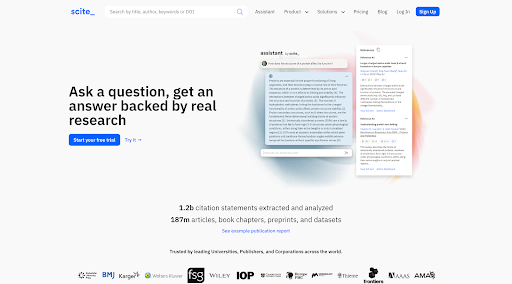
Key features:
- Citation context analysis: Scite analyzes citation contexts to determine whether they support, contradict, or simply mention the cited work.
- Innovative citations: It offers ‘smart citations’ that present the context of how a paper has been cited, enhancing understanding and critical evaluation.
- Comprehensive database: Access to a vast database of scholarly articles and citation analysis.
2. Consensus
Consensus is an AI tool designed to synthesize and summarize research findings from multiple sources. It helps researchers quickly grasp the consensus on specific topics, streamlining the literature review process. Consensus uses NLP to scan and analyze various academic research papers, providing summaries highlighting key findings and prevailing opinions. This tool is handy for businesses and developers needing a quick and comprehensive overview of their field’s current state of research.
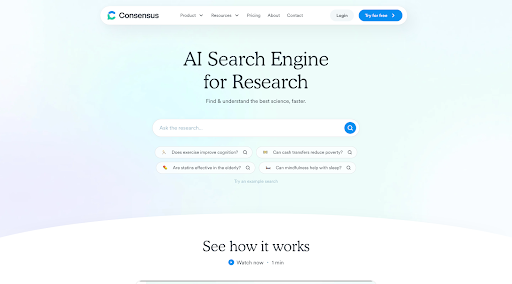
Key features:
- Automated summarization: Uses advanced algorithms to summarize research findings, providing a quick overview of consensus on various topics.
- Literature aggregation: This technique aggregates data from multiple research papers to comprehensively view current trends and opinions.
- User-friendly interface: An easy-to-navigate platform simplifying the literature review process.
3. Connected Papers
Connected Papers is a unique tool that helps researchers visualize the relationship between academic papers. It creates a graph of related papers, making it easier to discover influential works and new research paths. By constructing a visual graph based on co-citations and shared references, Connected Papers allows researchers to comprehensively explore a particular research topic’s landscape. This visualization helps identify seminal works, understand the development of ideas over time, and discover less-cited but potentially groundbreaking papers.
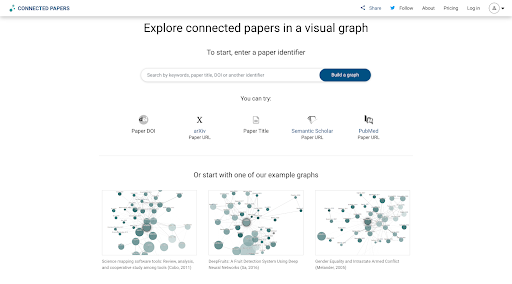
Key features:
-
Research graphs: Visualizes the connections between papers based on co-citations and shared references, highlighting influential works.
-
Exploration mode: Allows users to explore papers that are less cited but potentially groundbreaking, encouraging the discovery of novel research.
-
Interactive interface: Offers an interactive and user-friendly interface for navigating the research landscape.
4. Research Rabbit
Research Rabbit is a powerful AI-driven tool that facilitates the discovery and organization of research papers. By allowing users to build and explore collections of academic papers, Research Rabbit helps researchers track new developments and collaborate effectively. It employs algorithms to analyze research patterns and recommend relevant documents, creating a dynamic and interactive research environment. This tool is handy for researchers seeking to maintain a comprehensive and organized repository of literature.
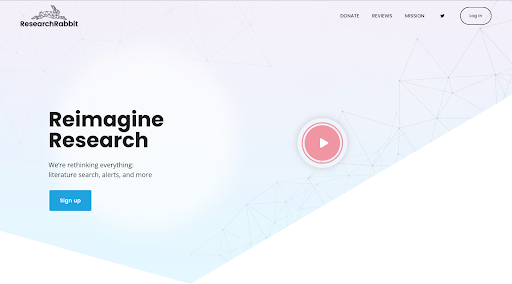
Key features:
-
Paper collection and organization: Users can build and organize collections of research papers, making it easier to manage and review large volumes of literature.
-
Recommendation engine: Provides recommendations for additional relevant papers based on user preferences and research patterns.
-
Collaboration tools: Facilitates collaboration by allowing multiple users to share and discuss research findings within the platform.
5. Elicit
Elicit is an AI tool designed to streamline research by automating systematic reviews and data extraction. It helps researchers gather, organize, and analyze research data efficiently, facilitating evidence-based decision-making. Elicit uses NLP to extract relevant information from academic papers and presents it in a structured format, simplifying the review process.
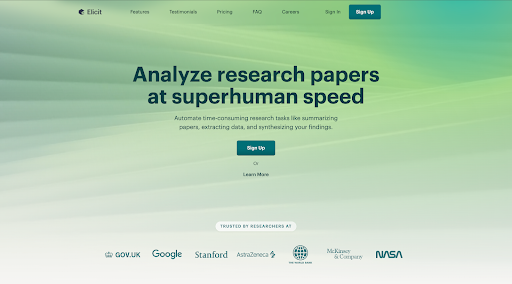
Key features:
-
Automated systematic reviews: Automates the process of conducting systematic reviews, saving time and ensuring thoroughness.
-
Data extraction: This technique uses NLP to extract and organize key data points from research papers, providing structured and accessible information.
-
Customizable templates: Offers templates for various research tasks, improving flexibility and efficiency.
6. Paperpal
Paperpal is an AI tool designed to assist researchers in improving the quality of their academic writing. By providing real-time feedback on grammar, style, and structure, Paperpal helps ensure that research papers meet high standards of clarity and coherence. It also offers suggestions for improving overall readability and impact, making it useful for both writing and editing research documents.
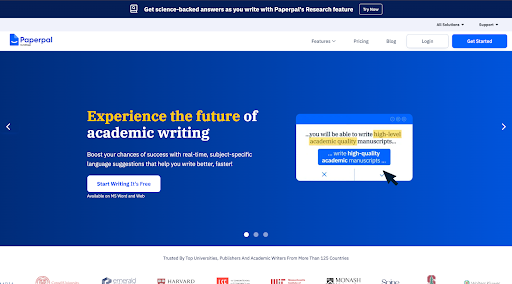
Key features:
-
Real-time writing assistance: Provides instant feedback on grammar, style, and structure, helping researchers improve the quality of their writing.
-
Readability enhancements: Offers suggestions for enhancing readability and impact, ensuring that research papers are clear and engaging.
-
Comprehensive editing tools: Includes various editing tools for refining academic writing and ensuring adherence to publishing standards.
7. Wevo
Wevo is an AI-driven tool designed to optimize and automate user experience (UX) research. It helps businesses analyze user feedback and behavior through advanced AI algorithms, providing actionable insights to improve product usability and customer satisfaction. Wevo’s capabilities extend to usability testing, user journey analysis, and behavioral analytics, making it a valuable asset for developers and product managers aiming to enhance user experience.
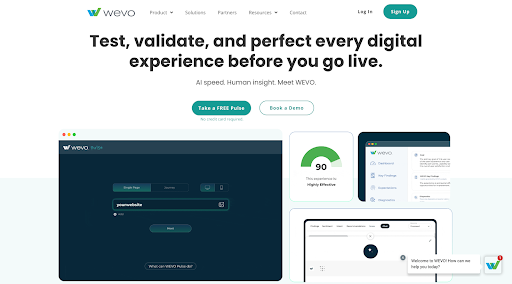
Key features:
-
Automated UX analysis: Utilizes AI to automatically analyze user feedback and behavior, identifying critical areas for improvement.
-
Behavioral insights: Provides insights into user interactions and journey patterns, helping to refine UX design.
-
Real-time feedback: Offers real-time analysis and recommendations based on current user data.
8. Litmaps
Litmaps is a visualization tool that helps researchers track and map the development of academic literature over time. By creating dynamic, interactive maps of research papers and their relationships, Litmaps allows users to explore how ideas, relevant literature, and research topics evolve. This tool is handy for understanding the progression of research areas and discovering new and relevant papers.
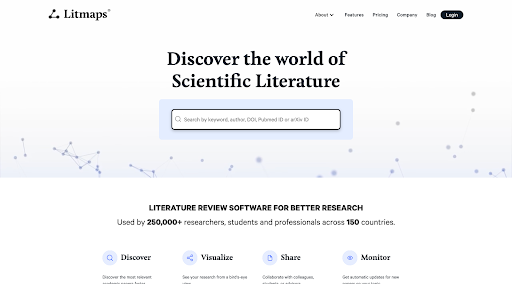
Key features:
-
Interactive research maps: Creates visual maps of academic literature, showing the connections and evolution of research topics.
-
Dynamic updates: Provides real-time updates and visualizations as new papers and citations are added.
-
Trend analysis: Users can track trends and developments within specific research areas.
9. Scinapse
Scinapse is an advanced academic search engine designed to simplify the discovery of relevant research papers. It leverages AI to provide comprehensive search capabilities, including filtering, sorting, and ranking scientific papers and academic articles. Scinapse’s algorithms help users find pertinent research quickly, making it easier to stay updated on their field’s latest advancements and discoveries.
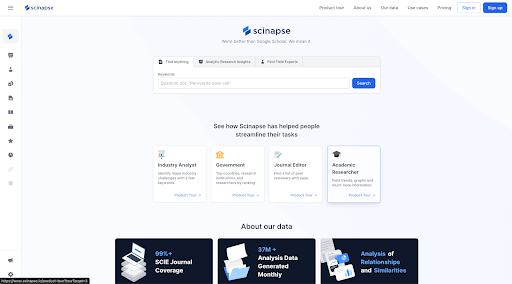
Key features:
-
Enhanced search functionality: AI provides detailed search capabilities, including advanced filtering and sorting options.
-
Comprehensive database: Accesses academic papers from various disciplines, ensuring broad coverage.
-
Relevance ranking: Ranks research papers based on relevance and impact, facilitating the discovery of high-quality studies.
10. Bit AI
Bit AI is an AI-powered collaboration and knowledge management platform designed to streamline the documentation and sharing of research insights. It helps teams organize and manage their research content effectively by providing tools for collaborative writing, content integration, and data visualization. Bit AI’s advanced features support the creation of comprehensive research documents and facilitate seamless team collaboration.
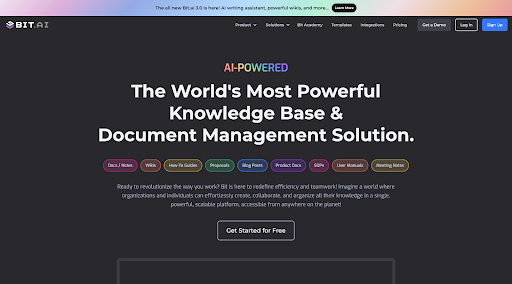
Key features:
-
Collaborative document editing: Provides real-time collaborative editing tools that allow multiple team members to work on research documents simultaneously.
-
Content integration: Enables integration of various content types, including text, images, and data visualizations, into research documents.
-
Data visualization: Offers tools for creating interactive charts and graphs, enhancing the presentation of research findings.
11. Perplexity
Perplexity is an AI-powered search engine that helps researchers find precise answers to complex questions by analyzing various academic papers and resources. It uses advanced NLP techniques to interpret queries and deliver relevant, context-rich answers. Perplexity is particularly beneficial for researchers looking to gather specific information quickly and efficiently, making it an invaluable tool for in-depth research.
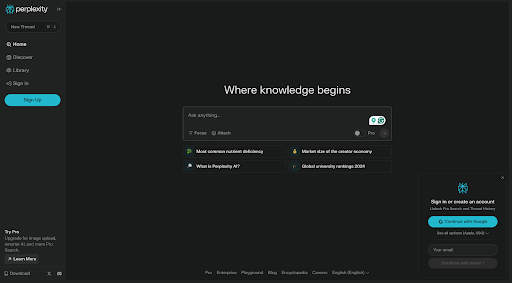
Key features:
-
Advanced query interpretation: Uses NLP to understand and process complex research questions, providing precise answers.
-
Context-rich results: Delivers answers with relevant context, ensuring comprehensive understanding of the query topic.
-
Extensive database: Access to a wide range of academic papers and resources for thorough research.
12. Patsnap
Patsnap is an advanced AI tool designed to assist research and development (R&D) teams in conducting comprehensive intellectual property (IP) research. Utilizing sophisticated machine learning algorithms, Patsnap enables users to parse through extensive patent databases and academic papers, providing valuable insights and comprehensive summaries. This tool is particularly beneficial for R&D teams who need to track technological advancements, identify trends, and conduct competitive analysis without excessive manual research.
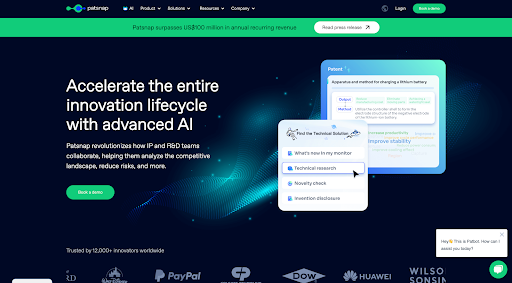
Key features:
-
Patent search and analysis: Perform comprehensive searches across global patent databases, analyzing patent landscapes to identify trends, opportunities, and potential risks.
-
Technology scouting: Discover emerging technologies and innovations in your field and monitor competitors’ R&D activities to identify potential collaboration opportunities.
-
Competitive intelligence: Gain insights into competitors’ IP strategies, track IP portfolios, and assess the strengths and weaknesses of competitors’ patents.
Build your company with DigitalOcean
For in-depth insights into cutting-edge AI developments and their real-world applications, visit the Paperspace blog. It provides valuable information for everyone, from novices to experienced professionals.
At DigitalOcean, we understand the unique needs and challenges startups and small to mid-sized businesses face. Our simple and transparent pricing and developer-focused cloud solutions, such as Droplets, Kubernetes, and App Platform, are designed to meet your needs.
Get started for free
Sign up and get $200 in credit for your first 60 days with DigitalOcean.*
*This promotional offer applies to new accounts only.